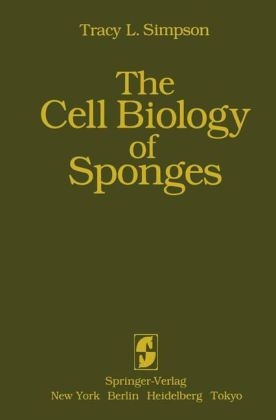
The Cell Biology of Sponges
Springer-Verlag New York Inc.
978-0-387-90893-9 (ISBN)
- Titel ist leider vergriffen;
keine Neuauflage - Artikel merken
Today, re- search on these phenomena is at the ultimate, molecular level. Through an as- semblage of characteristics the sponges are, based upon all available evidence, the most primitive Metazoans. Their tissues-perhaps one can say their cell groups-are loosely assembled (they possess no tight or gap junctions), cell dif- ferentiation appears highly labile, and they do not develop any true organs. But, they are most certainly Metazoans.
Morphology.- 1. Functional Morphology and Morphological Variation.- General Features.- Functional Morphology.- Variation in Morphology: The New Systematics.- Skeletal Morphology.- Spicule Geometry as a Major Morphological Feature.- Other Morphological, Reproductive and Biochemical Features.- Morphological Variation in the Phylum.- Cellular Structure.- 2. The Epithelia.- Pinacocytes (Excluding Hexactinellids).- Choanocytes (Excluding Hexactinellids).- Variation in Cell Shape.- Pinacoderm and Choanoderm in Hexactinellida.- Contractile Vacuoles and Water Balance.- 3. Cellular Components of the Mesohyl.- Cell Types and Structure.- Archeocytes, Polyblasts, Thesocytes.- Spongocytes, Gemmular Epithelium, Lophocytes, Trophocytes, Megasclerocytes.- Histoblasts, Collencytes, Fiber Cells, Myocytes, Neuroid Cells.- Microsclerocytes.- Special Cells-Cellules a Inclusions.- Summary of Special Cells.- The Cortex.- Cords of Cells.- Symbionts.- Cyanobacteria.- Zooxanthellae.- Zoochlorellae.- Bacteria.- Some Problems in Symbiont-Host Relationships.- Pigment.- Cellular Functions.- 4. Calcification, Silicification, Bioerosion.- Calcareous Deposits: Morphology, Chemistry, Distribution.- Calcareous Spicules.- Calcareous Scales.- Cemented Calcareous Spicules.- Aspicular Calcareous Deposits.- The Secretion of Calcareous Spicules.- Factors Affecting Calcareous Spicule Secretion.- Morphogenetic and Developmental Aspects of Calcareous Spicule Secretion.- The Secretion of Other Calcareous Structures.- Siliceous Deposits: Morphology, Chemistry, Distribution.- Siliceous Spicules of Demosponges.- Siliceous Scales.- Siliceous Spicules of Hexactinellids.- Cemented Siliceous Spicules.- Entrapped Siliceous Spicules.- The Secretion of Siliceous Spicules.- Demosponges.- Hexactinellids.- Factors Affecting Siliceous Spicule Secretion.- Morphogenetic and Developmental Aspects of Siliceous Spicule Secretion.- The Secretion of Other Siliceous Structures.- Iron Containing Deposits.- Excavation of Calcareous Substrata.- General Features of Burrowing and the Species Involved.- Cellular Basis of Etching.- Mechanisms of Burrowing.- Morphogenetic Aspects of Burrowing.- 5. Collagen Fibrils, Spongin, Matrix Substances.- Collagen: Morphology, Chemistry, Distribution.- Collagen Fibrils.- Spongin Fibers.- Gemmule Coats.- Collagen Synthesis and Secretion.- Biochemical Aspects of Collagen Synthesis.- Cellular Aspects of Collagen Secretion.- Other Organic Products.- Biochemical Studies.- Cytochemical and Morphological Studies.- Fibronectin.- Morphogenetic and Developmental Aspects of Organic Matrix Substances.- 6. Canal System Structure and Activities.- Ostia.- Structure in Calcarea.- Structure in Demospongiae.- Structure in Hexactinellida.- Development.- Incurrent Canals.- Inhalant "Organs".- Papillae.- Other Patterns.- Cellular Features.- Development.- The Terms Prosopyles and Apopyles.- Aphodal, Diplodal, Asconoid, and Syconoid Arrangements.- Pinacocytic Prosopyles.- Choanocytic Prosopyles.- Choanocyte Chambers.- Structural Heterogeneity of Chambers.- Development.- Choanocytic Apopyles.- Pinacocytic Apopyles.- Excurrent Canals.- Structure.- Development.- Morphological Patterns.- Oscules.- Morphological Types.- Cellular Features.- Development.- Canal System Elements in Reproductive Stages.- Water Currents.- Origin and Direction.- Transport Rates and Velocities.- Types of Changes in Water Transport.- Effectors Which Directly Influence Water Currents.- Responses of Effectors to Experimental Stimuli.- Spontaneous Changes in Water Currents.- Environmental Factors Influencing Water Currents.- Intrinsic Control of Water Currents.- Coordination by Neuroid Cells.- Feeding.- Retention of Particulates.- Sites of Entrapment-Ingestion.- Distribution and Digestion.- Elimination.- Development.- 7. Gamete, Embryo, Larval Development.- General Features of Sexual Reproduction.- Gametogenesis.- Spermatogenesis.- Oogenesis.- Nurse Cells.- Factors Influencing Gametogenesis.- Temperature.- Size of Animals.- Age and Other Factors.- Sex Determination.- Gamete Release.- Fertilization.- Cleavage.- Somatic Cells Associated with Embryos.- Polarity, Micromeres, Macromeres.- Larval Formation.- Larval Structure.- Processes in Larva Formation.- Reports of Asexually Formed Larvae.- Embryo and Larva Release.- Attachment of Larvae to the Substratum.- The Problem of the Polarity of the Larva.- Larval Metamorphosis.- Experimental Embryology.- 8. Buds, Gemmules, Tissues Regression.- Buds.- Fragmentation: A Special Case of Budding.- Budding.- Gemmules.- Occurrence of Gemmule Producing Species.- Life Cycles Involving Gemmules.- The Gemmule Envelope.- The Gemmular Cells-Thesocytes.- Gemmule Formation in Spongillids.- Gemmule Formation in Marine Species.- Determinants of Gemmule Formation.- Gemmule Dormancy.- Gemmule Germination.- Gemmule Hatching.- Tissue Regression.- A Special Case of Tissue Regression: Reduction Bodies.- 9. Growth, Regeneration, Cell Recognition, Perspective on Cell Differentiation.- Growth.- Initiative Growth.- Maturational Growth.- Remodeling.- Growth as an Increase in Size or Volume.- Experimental Regeneration.- Explants.- Transection of Whole Animals.- Tissue Ablation.- Tissue Recognition.- Reaggregation and Reconstitution of Dissociated Cells.- Perspective on Cell Differentiation.- References.
| Zusatzinfo | biography |
|---|---|
| Verlagsort | New York, NY |
| Sprache | englisch |
| Gewicht | 1520 g |
| Themenwelt | Naturwissenschaften ► Biologie ► Ökologie / Naturschutz |
| Naturwissenschaften ► Biologie ► Zellbiologie | |
| Naturwissenschaften ► Biologie ► Zoologie | |
| ISBN-10 | 0-387-90893-5 / 0387908935 |
| ISBN-13 | 978-0-387-90893-9 / 9780387908939 |
| Zustand | Neuware |
| Haben Sie eine Frage zum Produkt? |
aus dem Bereich


